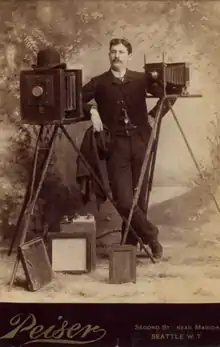
Theodore E. Peiser (1853 - 1922) was an early photographer in Seattle, Washington and the Pacific Northwest.[1] His studio and many of his photographs were lost in the Great Seattle Fire of 1889.[2] His surviving photographs include one of the few photographs of the Seattle skyline from Beacon Hill before the fire[3] as well as the Yesler-Leary Building in 1885, several years before it burned in the fire. He also captured the first and second Occidental Hotel buildings that preceded the Seattle Hotel and Sinking Ship. He also documented the debut of the first Seattle Street Railway horse-drawn streetcar in 1884 with mayor John Leary.
.jpeg.webp)
Peiser photographed the memorial service for assassinated U.S. president James Garfield held in Occidental Square in front of the Occidental Hotel on September 27, 1881. He also captured the territory's legislators in 1883.
Peiser photographed the Washington Husky football team in 1900, not long after statehood and the school's transition from being Territorial University of Washington. He also photographed Arthur A. Denny[4] and a then elderly pioneer Carson D. Boren. He captured images of the area's legislators, such as Samuel H. Piles addressing a crowd at the dedication of the Alki Point Monument. He also photographed Henry Yesler and his wife Sarah.
Peiser photographed groups of students and faculty at the Territorial University (predecessor of University of Washington). His images also included Soapy Smith.[5]
.jpeg.webp)
.jpeg.webp)
Peiser photographed sights at Alki Point including bathers at Alki Beach and the Stockade Hotel on the day a pioneer monument (Alki Point Monument) was being dedicated.[6] He also photographed firemen[7] and community leaders such as businessmen.[8]
Peiser lived at 7543 Sunnyside Avenue in Seattle. After the fire and its devastation to his business he fell ill. His doctor advised him to move to California and he planned to sell off his remaining photographic works and equipment.[2]
Peiser moved to California in 1907. He died there in 1922.
Writings and testimony
Peiser included poetry in his newspaper advertisement. He wrote a July 1, 1919 column in The Evening News (San Jose) about Emerson P. Harris' book Cooperation and the hope of the consumer about combatting high prices.[9] Peiser testified about the immigration of Japanese people to San Francisco in a congressional committee hearing in 1921. He recalled his time in Hawaii from 1879 until 1880 during the hearing and expressed fears about the immigration of Japanese people.[10]
Work
His work includes cabinet photos.
.jpeg.webp)
A collection of his photographs is held by the University of Washington.[2]
Gallery
.jpeg.webp) Soldiers at Fort Lawton
Soldiers at Fort Lawton.jpeg.webp) Seattle Bank baseball team
Seattle Bank baseball team.jpeg.webp) Bird's eye view of Seattle looking east
Bird's eye view of Seattle looking east.jpeg.webp) View of Seattle from Denny Hill in 1882
View of Seattle from Denny Hill in 1882.jpeg.webp) In front of The Owl
In front of The Owl.jpeg.webp) 1888 Fourth of July Parade on First Avenue
1888 Fourth of July Parade on First Avenue.jpeg.webp) Soldiers preparing to go to China in 1900 (Boxer Rebellion)
Soldiers preparing to go to China in 1900 (Boxer Rebellion).jpeg.webp) Seattle waterfront north from King St from Elliott Bay
Seattle waterfront north from King St from Elliott Bay.jpeg.webp) Central School and students in 1884
Central School and students in 1884.jpeg.webp) Looking northeast from King Street and Western Avenue (1881)
Looking northeast from King Street and Western Avenue (1881).jpeg.webp)
.jpeg.webp) Seattle Volunteer Fire Company engine Number 1 in 1883 at the engine house on Columbia Street
Seattle Volunteer Fire Company engine Number 1 in 1883 at the engine house on Columbia Street
See also
Further reading
References
- ↑ "::: Theodore E. Peiser Photographs of Washington State, ca. 1864-1910 :::". content.lib.washington.edu.
- 1 2 3 "Archives West: Theodore E. Peiser photographs, circa 1874-1905". archiveswest.orbiscascade.org.
- ↑ "Beacon Hill didn't beckon to too many pioneer photographers". 24 May 2018.
- ↑ "From a vaulted bank to an underground bar". Seattle Times. 1 February 2018.
- ↑ Peiser, Theodore E (3 October 1898). "Soapy Smith's" saloon, Skagway, Alaska. OCLC 67381596 – via Open WorldCat.
- ↑ "Stockade Hotel exterior at Alki Point on the day the pioneer's monument was dedicated, West Seattle neighborhood, Seattle, November 13, 1905 :: Theodore E. Peiser Photographs of WA State". cdm16786.contentdm.oclc.org.
- ↑ "Seattle Historical Photograph Collection". proofing.spl.org.
- ↑ "From a vaulted bank to an underground bar". 1 February 2018.
- ↑ "The Evening News - Google News Archive Search". news.google.com.
- ↑ Committee On Immigration And Naturalization, United States. Congress. House (1921). "Japanese Immigration: Hearings".